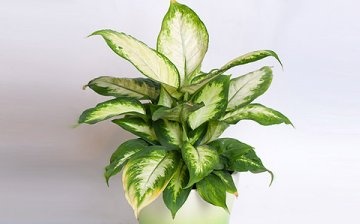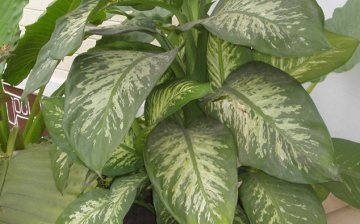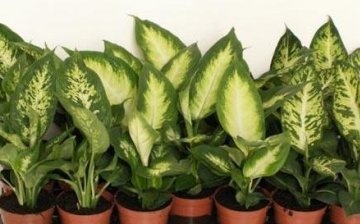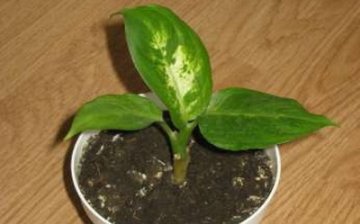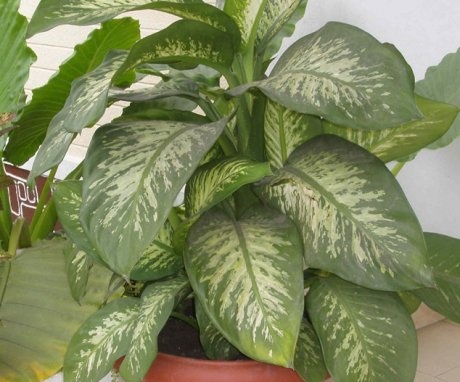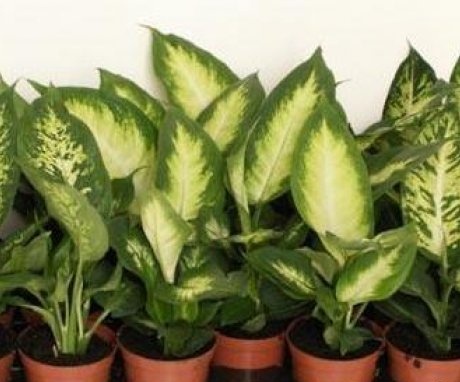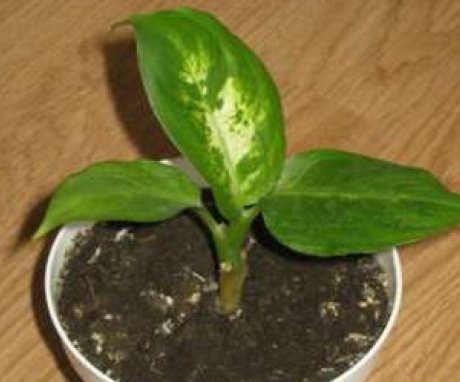Dieffenbachia: description, reproduction, care and plant transplant
Dieffenbachia is a shrub evergreen. It has a straight, strong green stem. The leaves are considered especially attractive. They are large, wide, and have a unique pattern. The green leaf has lighter streaks, spots, dots, stripes, etc.
Content:
- What is Dieffenbachia
- Growing and caring for dieffenbachia
- Reproduction and transplantation of a plant
What is Dieffenbachia
Dieffenbachia was first discovered by an Austrian botanist. In nature, there are about 30 types of dieffenbachia. Naturally, they grow in South America in tropical climate... Dieffenbachia leaf has not only a beautiful color, but also an interesting shape. Each sheet is strictly symmetrical.
Botanical scientists have not yet come to a consensus on the classification of dieffenbachia species. This is due to the fact that new hybrids are constantly appearing, which are difficult to isolate. Plus, botanists are developing new varieties.
The most popular type of dieffenbachia is Spotted. This species has 17 different varieties.
The most common color is marble. It is characterized by color transitions from light green to dark green. You can often find other dieffenbachia colors. When the leaf plate is lighter in the middle, due to the absence of chlorophyll, and at the edges is edged with a contrasting color.
The following types are grown at home:
- Spotted Dieffenbachia has a large green trunk. The leaves of the spotted species are large, up to 40 cm in length, alternately arranged, the pattern forms white spots and stripes. Spotted Dieffenbachia does not bloom at home. if this happened, then the special flowers are not noticeable against the background of gorgeous leaves. The flowers are small, white and yellow.
- Dieffenbachia Seguina has wide leaves. Her drawing is not so pronounced and not so contrasting. The pattern is located along the lateral veins.
- Bause. It stands out for its size, in height it can reach 90 cm. The maximum length of the leaves is 30 cm, they have a yellow-green color, a marble pattern, the leaf plate is covered with white dots.
- Bowman's hybrid can be with light or dark specks. The leaves reach a length of 75 cm.
All types of dieffenbachia have common similarities. However, each is beautiful and unique in its own way.
Growing and caring for dieffenbachia
Dieffenbachia are unpretentious plants, they grow quickly without requiring any extra investments from the owner. In the interior, they can be used in group plantings, as well as separately. The shrub will look rich and self-sufficient. How to care for diffinbachia will be discussed further.
The plant tolerates shade well, is not afraid of hot, dry air. In the room, some species can stretch up to 2 meters.
It is better to put a pot of shrubs near the window, since the plant is light-loving. It is not advisable that direct sunlight falls on the leaves, they can become dimmer, decrease in size.
As for watering, there is only one requirement, so that the earthy ball does not dry out... In the hot season, you need to carefully monitor this and water dieffenbachia regularly. If the humidity is low, then the leaves can be sprayed. For this, settled water at room temperature is used.
Dust can accumulate on the leaves, so they should be periodically wiped with a damp sponge.
When the period of active growth ends and the period of rest begins, then the withdrawal changes. This is due to a reduction in daylight hours and the amount of sunlight. If you continue to actively look after, then new small leaves may appear, which will spoil the entire appearance.
Top dressing is carried out 1 time per week throughout the entire period of active growth. If the plant is stretched up and the bare stem below looks ugly, then the trunk can be cut to the required length. New shoots will soon begin to grow from this place.
When growing dieffenbachia, you can face some difficulties:
- Loss of barrel elasticity.
- The leaves turn yellow and their edges curl.
- Leaves become faded.
- Leaves fall.
Solving difficulties:
- If the problem touched the stem, it became softer and began to rot, then this is due to the wrong watering regime and temperature. You can return the plant to its previous form by reducing the amount of watering and increasing the air temperature. First of all, you need to carefully cut out the damaged areas and sprinkle this area with charcoal. It is advisable to change the soil. If a large area of the trunk has deteriorated, then the plant can no longer be saved. You will have to root the upper part of the trunk, and discard the whole plant.
- If the leaves begin to curl, you need to check if a draft enters the plant. If the air temperature is below 10 degrees, then it will not be able to actively develop.
- If the leaves are not so bright, they may be exposed to direct sunlight, which will discolor them.
- If the leaves have begun to fall off, there may be several factors. First, the plant can go into a dormant period and shed old leaves. Secondly, it may have happened because of the dry soil. If young leaves fall, then it is possible that a draft gets on them or it is cold in the room.
Reproduction and transplantation of a plant
Reproduction is carried out in three ways:
- Apical cuttings.
- Stem cuttings.
- Air layering.
For successful rooting, a high air temperature must be maintained. If it turns out that dieffenbachia has bloomed, then the growth of the plant will stop. Lower leaves may fall. All forces will be directed to the development of flowers. Since they do not carry a decorative load, it is better to cut them off immediately. The plant needs replant periodically... This is due not only to the change in the size of the pot, but also to the need to renew the soil.
The transplant is carried out at least once every 4 years. The pot does not require a large volume. The soil is needed universal, for indoor plants. You can add charcoal to it.
Cuttings also perform an additional function: rejuvenating the plant. A knot should remain below the cut. The trimmed part can also be rooted. It is placed in the soil and watered as an adult plant. After a while, an shoot with leaves will appear from the node. It can be cut, planted in light soil.
How many nodes there are, so many new plants can be obtained.
For rooting, you can use water, sand, sand with peat, sphagnum. The main thing is that the direct sun does not fall on young cuttings. It is also necessary to spray and wipe the leaves. You can transplant the cutting into the soil when the roots grow 3 centimeters in length.
Rarely talk about the propagation of dieffenbachia by air layers. This operation is not so difficult to do:
- If there are no adventitious roots on the stem, then notches are made.
- Next, the trunk is wrapped in moist sphagnum moss and wrapped in opaque cellophane. The moss must not dry out, otherwise the roots will die.
- After the appearance of aerial roots, the cellophane is removed and the stem is cut off. The moss is removed and planted in the substrate. It is in the moss that the layers will be contained.
- Plant sap is poisonous, therefore, during any operations, you need to wear gloves and avoid contact with the skin and mucous membranes.
There is nothing difficult in growing a beautiful Dieffenbachia. It does not require much attention, but there are prerequisites that are vital for the plant.
More information can be found in the video.



